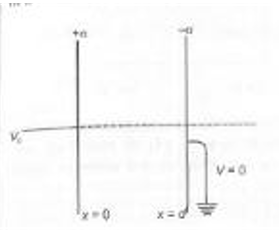The plates of a parallel plate capacitor are charged to a potential difference of 117 V and then connected across a resistor. The potential difference across the capacitor decreases exponentially with to time.After 1s the potential difference between the plates is 39 V, then after 2s from the start, the potential difference (in V) between the plates is
The correct Answer is:13
To solve the problem, we need to analyze the behavior of the potential difference across a discharging capacitor over time. The potential difference decreases exponentially, and we can use the formula for the voltage across a discharging capacitor:
V(t)=V0e−tRC
Where:
- V(t) is the potential difference at time t
- V0 is the initial potential difference (117 V)
- R is the resistance
- C is the capacitance
- t is the time in seconds
1. Identify the Initial Conditions:
- Initial potential difference V0=117V
- At t=1s, V(1)=39V
2. Set Up the Exponential Decay Equation:
- Using the formula for the voltage across the capacitor:
V(1)=V0e−1RC
Substituting the known values:
39=117e−1RC
3. Solve for the Exponential Term:
- Divide both sides by 117:
39117=e−1RC
Simplifying gives:
13=e−1RC
4. Take the Natural Logarithm:
- Taking the natural logarithm of both sides:
ln(13)=−1RC
5. Find the Voltage at t=2s:
- Now we need to find V(2):
V(2)=V0e−2RC
We can express this in terms of the previous result:
V(2)=V0e−2⋅(−ln(13))=V0(e−1RC)2
Substituting e−1RC=13:
V(2)=117(13)2=117⋅19=13V
Final Answer:
The potential difference between the plates after 2 seconds is 13 V.
- V(t) is the potential difference at time t
- V0 is the initial potential difference (117 V)
- R is the resistance
- C is the capacitance
- t is the time in seconds
- Initial potential difference V0=117V
- At t=1s, V(1)=39V
- Using the formula for the voltage across the capacitor:
V(1)=V0e−1RC
Substituting the known values:
39=117e−1RC
- Divide both sides by 117:
39117=e−1RC
Simplifying gives:
13=e−1RC
- Taking the natural logarithm of both sides:
ln(13)=−1RC
- Now we need to find V(2):
V(2)=V0e−2RC
We can express this in terms of the previous result:
V(2)=V0e−2⋅(−ln(13))=V0(e−1RC)2
Substituting e−1RC=13:
V(2)=117(13)2=117⋅19=13V
The potential difference between the plates after 2 seconds is 13 V.
Similar Questions
A capacitor is charged to a potential difference of 100 V and is then connected across a resistor. The potential difference across the capacitor decays exponentially with respect to time. After 1 sec, the P.D. between the plates of the capacitor is 80 V. what will be the potential difference between the plates after 2 sec ?
View SolutionA parallel plate capacitor is charged to a potential difference of 10 volts. After disconnecting the battery, distance between the plates of capacitor is decreased by using nonconducting handles. The potential difference between the plates will
View Solution
Knowledge Check
A parallel plate air capacitor is charged to a potential difference of V volts. After disconnecting the charging battery the distance between the plates of the capacitor is increased using an isulating handle. As a result the potential difference between the plates
AincreasesBdecreaseCdoes not chargeDbecomes zero
A parallel plate air capacitor is charged to a potential difference of V volts. After disconnecting the charging battery the distance between the plates of the capacitor is increased using an isulating handle. As a result the potential difference between the plates
View SolutionA parallel plate air capacitor is charged to a potential difference of V volts. After disconnecting the charging battery the distance between the plates of the capacitor is increased using an isulating handle. As a result the potential difference between the plates
View SolutionA capacitor of capacity 2μF is charged to a potential difference of 12V. It is then connected across an inductor of inductance 6μH. At an instant when potential difference across the capacitor is 6V, what is the current(in A)?
View SolutionA capacitor of capacitance C is charged to a potential difference V from a cell and then disconncted from it. A charge +Q is now given to its positive plate. The potential difference across the capacitor is now
View SolutionA capacitor of capacitance C is charged to a potential difference V from a cell and then disconncted from it. A charge +Q is now given to its positive plate. The potential difference across the capacitor is now
View SolutionA parallel plate capacitor charged to potential difference V0 . The variation of potential V from x= 0 to x= d is best described by

View SolutionA capacitor of capacity 2μF is changed to a potential different of 12V . It is then connected across an inductor of inductance 0.6mH What is the current in the circuit at a time when the potential difference across the capacitor is 6.0V ?
View Solution
